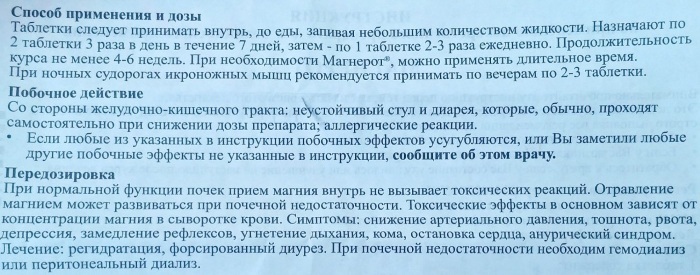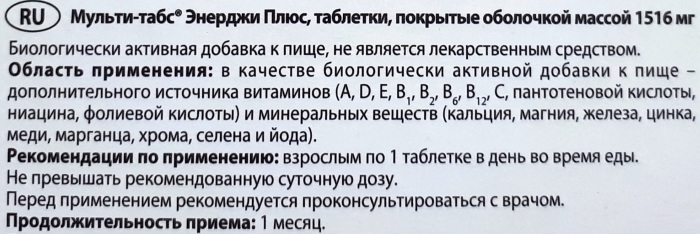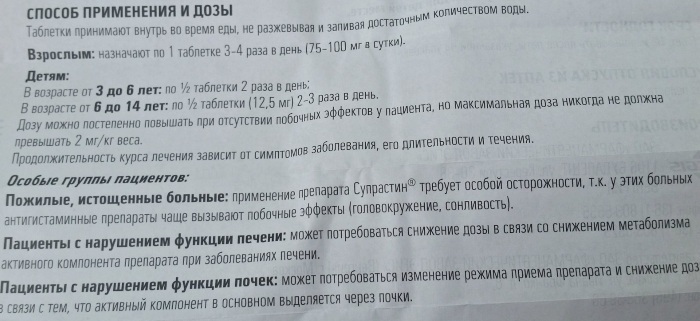Lidocaine is a remedy, which is often used for various disorders in patients accompanied by pain. However, a 10% solution is considered less popular than ampoules with a different concentration of active ingredient. Despite this, today a medicine with such a dosage is also used according to strict indications and after visiting a doctor.
Record content:
- 1 Release form and composition of 10% Lidocaine
- 2 Pharmacological properties
- 3 Pharmacodynamics and pharmacokinetics
- 4 Indications for use
- 5 Contraindications
- 6 Instructions for use, dosage
- 7 Side effects
-
8 Overdose
- 8.1 Symptoms
- 8.2 Treatment
- 9 special instructions
- 10 Drug interactions
- 11 Incompatibility
- 12 Use during pregnancy and lactation
- 13 The ability to influence the reaction rate when driving or driving other mechanisms
- 14 Analogs
- 15 Terms, conditions of sale and storage
- 16 Price
- 17 Video about Lidocaine
Release form and composition of 10% Lidocaine
The drug can be found on drugstore shelves in several dosage forms. For example, in the form of a spray, gel or eye drops.
However, in ampoules, only a solution for parenteral administration with different concentrations of the active substance is produced. In addition to the 10% remedy, Lidocaine is produced with a mark of 1%, 2%. Spray for topical external use also has a 10% concentration of the main substance.
The solution is packaged in transparent glass ampoules, each of which contains 2 ml of the product. Ampoules are placed in a cardboard box of 10 pieces. They are also accompanied by instructions for the use of the medicinal product.
As the main active substance in the composition of the drug, there is a component of lidocaine hydrochloride, which is in solution in the form of a monohydrate. In addition, water for injection is present in any liquid dosage form as an auxiliary ingredient.

The additional component has no pharmacological properties. The solution is odorless, transparent and colorless, and there is no sediment at the bottom of the ampoule. The medicine is produced by a Russian, Belarusian and Hungarian pharmaceutical company.
Pharmacological properties
Lidocaine 10% in ampoules has several pharmacological properties. The active substance of the drug belongs to the group of acetanilide derivatives and has pronounced antiarrhythmic and local analgesic properties.
The drug acts on certain nerve endings, which lead to an increase in the heart rate, as well as the appearance of severe pain. As a result of the use of the drug, it is possible to significantly alleviate the course of pathologies accompanied by tachycardia, arrhythmia, and also eliminate pain in case of soft tissue damage.
The local anesthetic effect is carried out simultaneously with a decrease in the heart rate and normalization of the rhythm, which leads to the elimination of the pronounced symptoms of many somatic disorders, as well as pathologies on the part of the autonomic nervous systems. An additional advantage of the remedy is the absence of a pronounced effect on the contraction of the heart muscle.
The complex effect of the drug on the body allows it to be used as the main and additional method of treating pathologies of internal organs.
Pharmacodynamics and pharmacokinetics
The drug is rather well and quickly absorbed in the patient's body after parenteral administration.
The active substance acts on the sodium channels in the nerve endings, leads to their blockage, which makes it possible to achieve a local anesthetic effect. It should be noted that the effect lasts for several hours, which depends on the individual characteristics of the patient's body.
The antiarrhythmic action is carried out due to the ability of lidocaine hydrochloride to increase the permeability of cell membranes. This allows potassium ions to better penetrate the membrane in order to normalize the heart rhythm and make myocardial contractions less frequent. When applied topically, vasodilation in the area of administration is noted, but there is no irritating effect.
It is worth noting that the active substance acts on the ventricles of the heart, but does not inhibit atrial contraction, which excludes the likelihood of aggravation of the symptoms of the underlying disease. Even with the introduction of large doses of the drug, experts do not notice a negative effect on the myocardium, which is also considered an advantage of the drug.
After local subcutaneous administration or the use of the drug intravenously, intramuscularly, its rather rapid absorption into the systemic circulation is noted. Bioavailability in each patient may differ depending on the dosage and duration of drug use.
However, on average, the indicator fluctuates between 60-80%. The active ingredient of the solution binds well to blood proteins, which explains the fast action.
Within 5-7 minutes after administration, the maximum concentration of the substance in the blood is noted, it remains at this level for 2-4 hours, depending on the dosage and some features organism. There is a slowdown in the absorption of the active substance in patients who suffer from liver and kidney pathologies.
The processing of the active ingredient is carried out in the liver, and the metabolites are excreted within 4-6 hours. The main part of the decay products of lidocaine is excreted with the help of the kidneys, a small part is evacuated with bile.
In patients with diseases of the urinary and digestive systems, there is a slowdown in cleansing the body from the decay products of the active component of the solution.
Indications for use
Lidocaine 10% is used for various pathological conditions.
The solution in ampoules is prescribed in the following cases:
- Heart pathologies, accompanied by disorders in the form of arrhythmias and advanced tachycardia.
- Prevention of complications and ventricular arrhythmias.
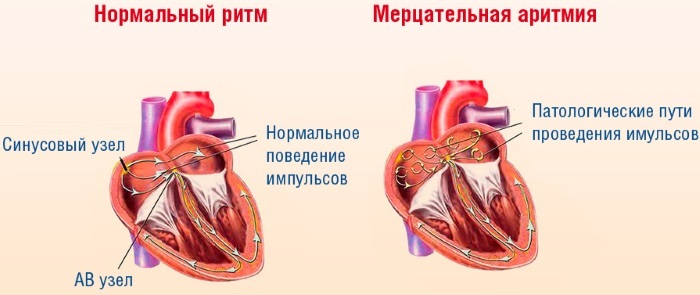
- Recovery period after surgery that has a negative effect on the heart.
- Neglected forms of angina pectoris, accompanied by frequent attacks, as well as heart rhythm disturbances.
- Small operations that do not require general anesthesia.
- Contraindications in the patient to the administration of drugs for general anesthesia.
In addition, the drug is used to relieve the symptoms of glycosidic intoxication in patients with ventricular arrhythmia. A solution in which the concentration of the active ingredient is 10% is rarely used as an epidural or in dental treatment.
However, in each case, the doctor individually decides on the prescription of a medicine with a particular dosage of the active substance.
Contraindications
The drug is not prescribed for women during pregnancy or lactation, since there is a high risk of developing negative reactions. In addition, the drug is contraindicated in case of allergy to its components or a history of similar manifestations.
Do not prescribe medication for severe chronic heart failure, advanced course of epilepsy have frequent seizures or seizures that occur spontaneously and are not a sign epilepsy. Contraindications include progressive atrioventricular blockade, as well as bradycardia and ventricular conduction disturbances.
Do not use the medicine when diagnosing advanced hypotension, cardiogenic shock, or severe liver disease. For example, cirrhosis of the liver, hepatitis of viral and other origin, liver failure is considered a reason for refusing to use the drug.
The drug is used with caution in the treatment of patients with hypovolemia, renal failure and sinus bradycardia.
Instructions for use, dosage
Lidocaine 10 percent in ampoules is commonly used for intravenous infusion through a dropper or jet. For different pathologies, the regimen and dosage may differ.
In case of arrhythmias and tachycardia, the administration of the drug is prescribed for 7-10 days, 1 time per day. Before administration, 1 ampoule of the drug is dissolved in 10-20 ml of 0.9% saline solution.
The procedure is carried out in a hospital setting. The introduction is carried out in a jet and very slowly. The syringe with the medicine is injected for at least 3-5 minutes, which reduces the risk of complications when a large dose of the medicine enters the bloodstream.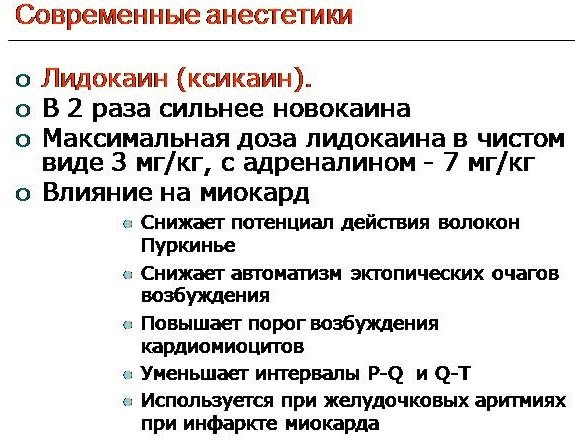
After administration, the patient is monitored, his blood pressure is measured and his pulse is counted to assess the effectiveness of the drug. If necessary, the treatment is extended by 3-5 days, and the dosage is doubled, but according to strict indications.
If the agent needs to be administered drip, then 2 ml of Lidocaine is added to 500 ml of Ringer's solution. The introduction is carried out slowly, the patient's condition is constantly monitored. The procedure is carried out daily for 1-2 weeks, depending on the state of neglect.
When a patient is diagnosed with a severe form of heart failure, the daily dosage of the medication is reduced by 40%, which reduces the risk of negative reactions. It is categorically contraindicated to independently prolong the course and increase the dose of the medication.
Side effects
Adverse reactions during the period of therapy appear not only when instructions are violated, but also with strict adherence to all the rules. They usually affect internal organs and systems.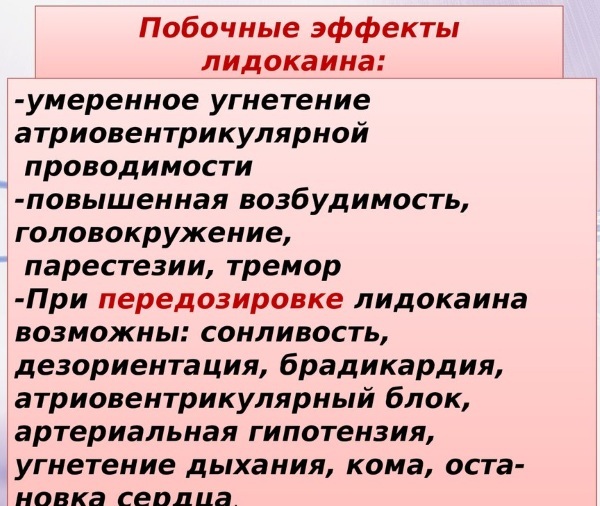
| Organs and systems | Most common reactions |
| Nervous system | Headache and dizziness appear frequently with the use of the medication. Additionally, the patient may be disturbed by drowsiness, weakness and decreased performance. Some patients report excessive excitability, anxiety and even euphoria. Patients often talk about the appearance of tinnitus. |
| Heart and blood vessels | A decrease in blood pressure indicators is observed in about 10% of all patients. In this case, there is a violation of the conduction of the heart and severe bradycardia. The latter symptom is considered dangerous as it increases the risk of cardiac arrest. |
| Digestive tract | The most common disorder on the part of the digestive system is nausea, which is aggravated by the ingestion of food or a large amount of liquid. Constipation or loose stools are rare, but flatulence, bloating, and pain in the bowel area are possible. |
| Musculoskeletal system | Joint and muscle pain occurs quite often, while tremors or seizures may develop that are not associated with any neurological disorders. |
| Skin | A skin rash is considered the first sign of an allergy. A little later, itching joins, areas of peeling and irritation appear. As a rule, symptoms are not aggravated in the case of timely initiation of therapy. |
The severity of adverse reactions depends on the patient's body, the duration of the course and the dosage of the medication.
Overdose
Lidocaine 10% in ampoules is a concentrated agent, therefore, it often provokes an overdose if the instructions are violated or the dose is independently increased. As a rule, all adverse reactions are aggravated, and there is also a threat to the patient's life.
Symptoms
The patient's condition worsens in case of an overdose.
In this case, the following symptoms appear:
- Strong headache.
- Dizziness and lack of coordination of movements.

- Feeling of euphoria, inability to navigate in space.
- Unreasonable fear and anxiety.
- Deterioration in the quality of vision.
- Convulsive seizures.
- Limb tremor.
- Breathing disorder, up to suffocation.
- Loss of consciousness.
In advanced cases, the development of a coma and even death is possible.
Treatment
For therapy, constant monitoring of blood pressure and heart rate indicators is required. In addition, the doctor constantly checks the patency of the airways, if necessary, the patient is injected with oxygen.
Additionally, kidney function monitoring is required, since disorders on the part of the paired organ provoke complications, and hemodialysis is ineffective in case of an overdose.
Among the medicines, several groups can be distinguished, which are used depending on the symptoms that the patient has:
- Benzodiazepines (Diazepam) are prescribed for seizures. The dosage is determined individually.
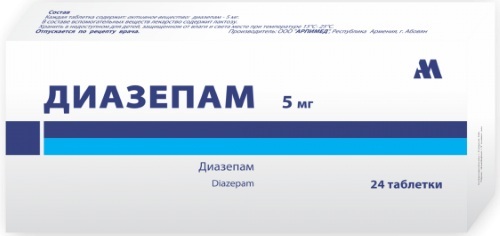
- Atropine is prescribed for severe bradycardia in a patient. The dose is determined individually, the agent is administered intravenously.
- Short-acting barbiturates (Pentobarbital) are indicated for tremors and cramps in the extremities.
In the presence of other manifestations, symptomatic therapy is used. In case of cardiac arrest, resuscitation measures are taken to restore the functioning of the organ.
special instructions
The use of the product is carried out only after examination by a doctor. The specialist must be sure that there are no contraindications and the risk of negative reactions from the internal organs.
For elderly patients, as well as for patients with mental retardation, the medicine is prescribed with caution, only under the supervision of a physician. When applied externally for the purpose of local anesthesia, it is important to inject by dissolving areas where there is no large accumulation of blood vessels, since there is a risk of bleeding.
If there are signs of an overdose or other adverse reactions, you should immediately consult a doctor.
Drug interactions
Lidocaine 10% in ampoules is used simultaneously with drugs from the group of antibiotics, non-steroidal anti-inflammatory and antihypertensive drugs. The action of these funds is not weakened or enhanced in combination with the solution.
It is allowed to administer the medicine when the patient is taking sedatives, vitamin complexes or homeopathic remedies. Despite this, the decision on drug interactions in each case is made by the doctor individually.
Incompatibility
The product cannot be used in combination with many medicines.
The main ones are:
- Muscle relaxants.
- Analgesics of the opioid group.
- Local anesthetics based on novocaine.
- Calcium channel blockers.

- Antihypertensive drugs.
- Cardiac glycosides.
The use of lidocaine simultaneously with these medicines enhances or weakens their effect, and can also increase toxicity, which is dangerous for the patient's life.
If the patient is taking any medications, it is worth informing the doctor about this before prescribing Lidocaine.
Use during pregnancy and lactation
The drug is categorically contraindicated to use when carrying a child and during lactation. Its active substance penetrates into breast milk and through the placental barrier, therefore, it can negatively affect the health of the child.
The use of the medicine is possible for health reasons, but only in the case when the benefit to the mother is higher than the expected harm to the child.
The ability to influence the reaction rate when driving or driving other mechanisms
The drug has a negative effect on the patient's reaction and his ability to navigate in space, and also impairs the coordination of movements. That is why, during treatment, you should not drive vehicles or perform work that requires extreme concentration.
Analogs
The tool has analogues that are used if it is impossible to assign the original.
The most popular and effective substitutes:
-
Novocaine - an agent based on procaine, which has a local anesthetic effect, and is also used in the system of complex treatment of hypertension and other pathologies of the cardiovascular system. The drug is available in the form of a solution, administered intravenously and topically for the purpose of temporary pain relief.

- Ultracaine - an analogue of a drug based on articaine, which has more pronounced properties than lidocaine. The tool is used for various disorders of the heart and blood vessels, as well as for the purpose of local anesthesia.
Any of the analogues can only be used as directed by a doctor. Self-medication can be dangerous not only for health, but also for the patient's life.
Terms, conditions of sale and storage
It is necessary to store the medicinal solution in a cool and dark place, it is important to limit the access of children and direct sunlight.
The maximum shelf life is 5 years. It is strictly forbidden to use the solution after the expiration date. You can buy medication at the pharmacy with a doctor's prescription.
Price
The cost of a medicine in pharmacies differs depending on the manufacturer and the region of distribution. The average price ranges from 30-80 rubles.
Lidocaine 10% is considered a less common form of the drug in ampoules, but it is quite often used for therapy and local anesthesia. The drug does not harm the body if used correctly, but the doctor should prescribe it in the absence of contraindications and after examination.
Video about Lidocaine
Action of lidocaine:

